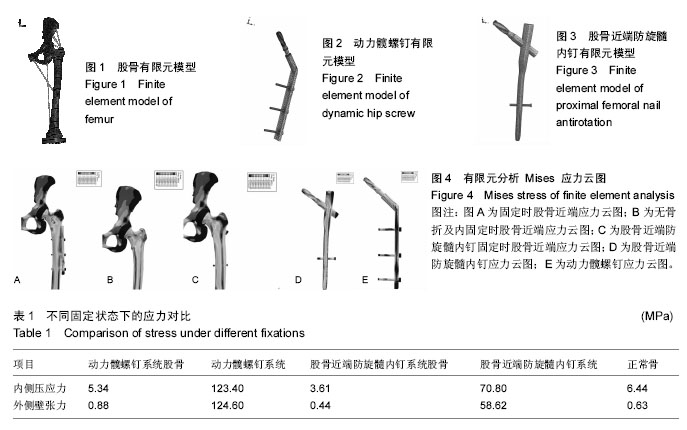| [1] Fichman SG, Mäkinen TJ, Safir O, et al. Arthroplasty for unstable pertrochanteric hip fractures may offer a lower re-operation rate as compared to cephalomedullary nailing. Int Orthop. 2015;40(1):1-6.
[2] Bhakat U, Bandyopadhayay R. Comparitive Study between Proximal Femoral Nailing and Dynamic Hip Screw in Intertrochanteric Fracture of Femur. Open J Orthop. 2013;3(7):291-295.
[3] Aktselis I, Kokoroghiannis C, Fragkomichalos E, et al. Prospective randomised controlled trial of an intramedullary nail versus a sliding hip screw for intertrochanteric fractures of the femur. Int Orthop. 2014; 38(1):155-161.
[4] Guo XF, Zhang KM, Fu HB, et al. A comparative study of the therapeutic effect between long and short intramedullary nails in the treatment of intertrochanteric femur fractures in the elderly. Chin J Traumatol. 2015;18(6):332-335.
[5] Simmermacher RK,Ljungqvist J,Bail H,et al.The new proximal femoral nail antirotation(PFNA) in daily practice:results of a multicentre clinical study.Injury. 2008;39(8):932-939.
[6] 杨灵,江伟,刘跃洪,等.股骨近端锁定钢板治疗股骨转子间骨折的生物力学研究[J].创伤外科杂志, 2015,(02): 135-137.
[7] Chang CW, Chen YN, Li CT, et al. Role of the compression screw in the dynamic hip–screw system: A finite-element study. Med Eng Phys. 2015;37(12): 1174-1179.
[8] Widjaja W, Hartung C. Finite element analysis of an additional implant for intramedullary nailing. Biomed Tech Ber. 2000;45(12):338-342.
[9] Wu X, Yang M, Wu L. A Biomechanical Comparison of Two Intramedullary Implants for Subtrochanteric Fracture in Two Healing Stages: A Finite Element Analysis. Appl Bionics Biomech. 2015;2015:1-7.
[10] Chen Y, Wang G, Zhou D, et al. Computational Study in Effects of Nail- and Plate-Implants on the Treatment of Pertrochanteric and Intertro-chanteric Fractures. Mat Perf Characterizat. 2015;4(1):17-28.
[11] Hou W, Zhang W, Zhao H. Analysis on three-dimensional finite element of rebuilding femoral calcar in femoral head replacement. J Modern Med Health. 2015;21(6):1585-1592.
[12] 王丽珍,赵峰,樊瑜波.新型带锁髓内钉在股骨转子间骨折愈合过程中的生物力学研究[J].医用生物力学,2011, 26(4): 305-309.
[13] Brown TD, Hild GL. Pre-collapse stress redistributions in femoral head osteonecrosis--a three-dimensional finite element analysis. J Biomech Eng. 1983;105(2): 171-176.
[14] Grecu D, Pucalev I, Negru M, et al. Numerical simulations of the 3D virtual model of the human hip joint, using finite element method. Rom J Morphol Embryol. 2010;51(1):151-155.
[15] Stewart KJ, Edmonds-Wilson RH, Brand RA, et al. Spatial distribution of hip capsule structural and material properties. J Biomech. 2002;35(11): 1491-1498.
[16] Wang YS, Zhang MC, Huang BS. A finite element stress analysis of severe intertrochanic fractures treated with artificial femoral head replacement. Chin J Clin Anat. 2013;31(5):577-581.
[17] Evans EM.The treatment of trochanteric fractures of the femur. J Bone Joint Surg(Br). 1949;31:190-203.
[18] Jensen JS.Classification of trochanteric fracture.Acta Orthop Scand.1980;51(5):803-810.
[19] Parker MJ. Trochanteric hip fracture.Fixation failure commoner with femoral medialization,a comparision of 101 cases. Acta Orthop Scand. 1996;67(4):329-332.
[20] Liang GK, Zakaria Z, Sharifudin MA, et al. Intertrochanteric fracture fixation with Dynamic Hip Screw: Is tip-apex distance measurement useful for predicting fixation failure? Int Med J Malays. 2016; 15(1):31-34.
[21] Li S, Chang SM, Jin YM, et al. A mathematical simulation of the tip-apex distance and the calcar-referenced tip-apex distance For Intertrochanteric fractures reduced with lag screws. Injury. 2016;47(6):1302-1308.
[22] Gotfried Y.The lateral trochateric wall:a key element in the reconstruction og unstable pertrochateric hip fracture.Clin Orthop Relat Res. 2004;425:82-86.
[23] Palm H,Jacobsen S,Sonne-Holm S,et al.Integrity of the lateral femoral wall in intertrochanteric hip fracture:an important predictor of reoperation. J Bone Joint Surg Am. 2007;9(3):470-475.
[24] Haq RU, Manhas V, Pankaj A, et al. Proximal femoral nails compared with reverse distal femoral locking plates in intertrochanteric fractures with a compromised lateral wall; a randomized controlled trial. Int Orthop. 2014;38(7):1443-1449.
[25] Mirzaei M, Keshavarzian M, Naeini V. Analysis of strength and failure pattern of human proximal femur using quantitative computed tomography (QCT)-based finite element method. Bone. 2014;64(7):108-114.
[26] Hambli R, Allaoui S. A Robust 3D Finite Element Simulation of Human Proximal Femur Progressive Fracture Under Stance Load with Experimental Validation. Ann Biomed Eng. 2013;41(12): 2515-2527.
[27] Kim Y,Bahk WJ,Yoon YC, et al. Radiologic healing of lateral femoral wall fragments after intramedullary nail fixation forA3.3 Intertrochan-teric fractures. Arch Orthop Trauma Surg. 2015;135(10):1349-1356.
[28] Kim Y, Bahk WJ, Yoon YC, et al. Radiologic healing of lateral femoral wall fragments after intramedullary nail fixation for A3.3 intertro-chanteric fractures. Arch Orthop Trauma Surg. 2015;135(10):1349-1356.
[29] Russell TA,Sander R.Pertrochanteric hip fracture:time for change. J Orthop Trauma. 2011;25(4):189-190.
[30] Kuzyk PR, Lobo J, Whelan D, et al. Biomechanical evaluation of extramedullary versus intramedullary fixation for reverse obliquity intertrochanteric fractures. J Orthop Trauma. 2009;23(1):31-38.
[31] 杨声波,陈文帅,沈伟冰.PFNA与DHS治疗23例老年股骨转子间骨折疗效对比分析[J].福建医药杂志, 2007,29(6): 35.
[32] Adams CL,Robinson CM,Court-brown CM,et al.Prospective radomized controlled trial of an intramedullary nailversus dynamic scrand plate for intertrochanteric fracture of femur.J Orthop Traum. 2001;15(2):394.
[33] 方大标,王秋根.医源性因素对DHS治疗髋部骨折疗效的影响[J].中华创伤骨科杂志,2004,6(5):525.
[34] 王建辉,刘长贵,刘瑞波.PFN和DHS治疗股骨转子间骨折的生物力学研究及临床疗效观察[J].骨与关节损伤杂志, 2004,19(11):739.
[35] Li H, Hepp P, Komer J, et al. Proximal humeral fractures: how stiff should an implant be? A comparative mechanical study with-implants in human spedmens. Arch Orthop Trauma Surg. 2003;123(2-3): 74-81.
[36] Kuzyk PR, Lobo J, Whelan D,et al. Biomechanical evaluation of extramedullary versus intramedullary fixation for reverse obliquity intertrochanteric fractures. J Orthop Trauma. 2009;23(1):31-38.
[37] Studer P, Suhm N, Wang Q, et al. Displaced trochanteric fragments lead to poor functional outcome in pertrochanteric fractures treated by cephalomedullary nails. Injury. 2015;329(12): 2384-2388.
[38] Boopalan PR, Oh JK, Kim TY, et al. Incidence and Radiologic Outcome of Intraop-erative Lateral Wall Fractures in OTA 31A1 and A2 Fractures Treated With Cephalomedullary Nailing. J Orthop Trauma. 2012;26: 638-642.
[39] 姜自伟,黄枫,庞智晖,等.股骨转子间骨折的三角固定理论[J].中国中医骨伤科杂志,2015,23(9):70-72. |
.jpg)

.jpg)
.jpg)
.jpg)
.jpg)